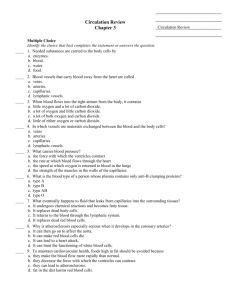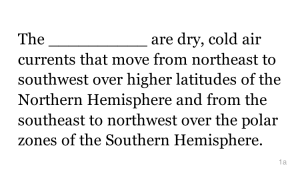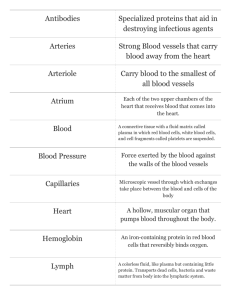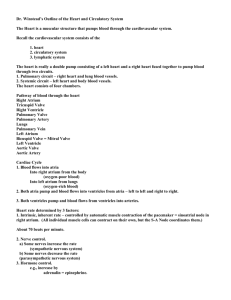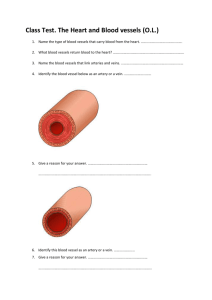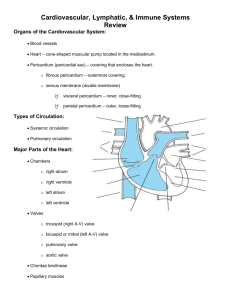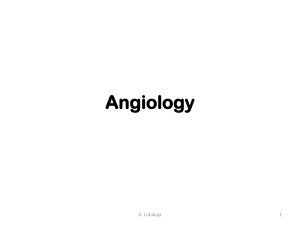Quiz - justinhames-middleleveled-itps-d
advertisement
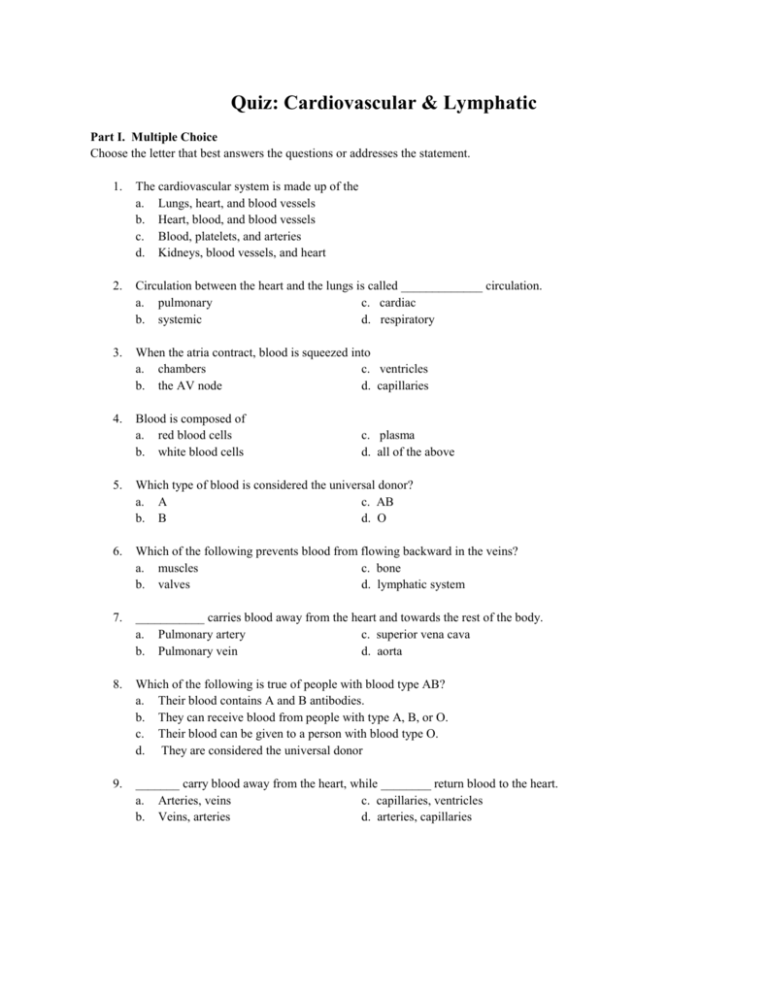
Quiz: Cardiovascular & Lymphatic Part I. Multiple Choice Choose the letter that best answers the questions or addresses the statement. 1. The cardiovascular system is made up of the a. Lungs, heart, and blood vessels b. Heart, blood, and blood vessels c. Blood, platelets, and arteries d. Kidneys, blood vessels, and heart 2. Circulation between the heart and the lungs is called _____________ circulation. a. pulmonary c. cardiac b. systemic d. respiratory 3. When the atria contract, blood is squeezed into a. chambers c. ventricles b. the AV node d. capillaries 4. Blood is composed of a. red blood cells b. white blood cells c. plasma d. all of the above 5. Which type of blood is considered the universal donor? a. A c. AB b. B d. O 6. Which of the following prevents blood from flowing backward in the veins? a. muscles c. bone b. valves d. lymphatic system 7. ___________ carries blood away from the heart and towards the rest of the body. a. Pulmonary artery c. superior vena cava b. Pulmonary vein d. aorta 8. Which of the following is true of people with blood type AB? a. Their blood contains A and B antibodies. b. They can receive blood from people with type A, B, or O. c. Their blood can be given to a person with blood type O. d. They are considered the universal donor 9. _______ carry blood away from the heart, while ________ return blood to the heart. a. Arteries, veins c. capillaries, ventricles b. Veins, arteries d. arteries, capillaries 10. Some white blood cells release chemicals called ______, which help destroy bacteria, viruses, and other microscopic particles that can make you sick. a. pathogens c. platelets b. antibodies d. nodes 11. __________ is the protein that allows for oxygen to attach to the surface of the red blood cells. a. hemoglobin c. plasma b. a lymph d. erythrocyte 12. When you exercise, your heart beats faster because a. more blood cells are made c. your muscles require much oxygen b. your systolic pressure gets too low d. you are having a heart attack 13. Your _________ valve is located between the right atrium and the right ventricle. a. semilunar c. tricuspid b. bicuspid d. aortic 14. The human body contains an average of about ______ of blood a. 7 L c. 1 L b. 5 L d. 3 L 15. Which of the following is not a main function of blood? a. transportation of oxygen c. destroys harmful pathogens b. rids of wastes such as carbon dioxide d. creating bone marrow 16. _________ refers to the circulation between the heart and the rest of body (excluding the lungs). a. blood pressure c. pulmonary circulation b. systemic circulation d. hypertension 17. Where diffusion takes place a. arteries b. heart c. veins d. capillaries 18. When using a diagram/model of blood vessels, the color blue is used to indicate a. that they are carrying deoxygenated blood cells b. that they are carrying too many white blood cells c. that they are carrying oxygenated blood cells d. that those blood vessels are suffering from atherosclerosis 19. These types of blood vessels have thick elastic walls that contain a layer of smooth muscle. a. veins c. arteries b. capillaries d. none of the above 20. Your ________, also known as the pacemaker, is responsible for the contraction of both atria. a. SA node c. septum b. AV node d. pericardium 21. _______ is a term used to describe abnormally high blood pressure. a. Atherosclerosis c. hypotension b. hypertension d. irregular pulse 22. Your AV node is responsible for a. causing both atria to contract b. sending the impulse to the SA node c. causing both ventricles to contract d. the opening of the bicuspid and tricuspid valves 23. ____________ is a cancer in which the body produces too many WBC’s. The WBC’s often grow too fast and become too large, causing them to overcrowd the body’s cells. a. Sickle Cell Anemia c. Leukemia b. Aneurysm d. Mitral Valve Regurgitation 24. The septum is responsible for a. Separating the right and left ventricles of the heart b. Preventing oxygenated blood from mixing with deoxygenated blood c. Contracting the ventricles of the heart d. Both “a” and “c” 25. What cause the fluid in the lymphatic system to move through the vessels? a. skeletal muscles c. thymus b. spleen d. heart 26. What is the largest organ of the lymphatic system? a. thymus c. tonsils b. tonsils d. spleen 27. What is the best way to prevent atherosclerosis and many other cardiovascular disorders? a. Do not smoke c. Eat a healthy diet b. Exercise regularly d. All of the above 28. What disease is the #1 killer of Americans? a. Cancer c. Atherosclerosis b. AIDS d. Sickle cell anemia 29. What is the function of the lymph nodes? a. Filter lymph b. Move lymph through the lymphatic system c. Filter the blood d. No real purpose 30. Which of the following is not a part of the lymphatic system? a. tonsils c. thymus b. spleen d. lungs 31. What happens to the lymph as it finishes passing through the lymphatic system? a. Sent to kidneys c. sent to the intestines b. Keeps moving in the lymphatic system d. released into large veins 32. Disease in which RBC’s become crescent-shaped, causing them to block blood vessels. a. Leukemia c. Mitral Valve Regurgitation b. Sickle Cell Anemia d. Atherosclerosis 33. ___________ is the permanent ballooning in the wall of an artery, usually the aorta. a. An Aneurysm c. Leukemia b. Heart Failure d. Sickle Cell Anemia Part II. Interpreting the pictures Use the heart diagram to match each heart structure with the correct corresponding letter. 34. _____Left Atrium 35. _____Right Atrium 36. _____Left Ventricle 37. _____Right Ventricle 38. _____Bicuspid Valve A B F E D 39. _____Tricuspid Valve C B Part III. Lab Questions: When you are called upon, please go to the back of the room to answer the LAB questions #40-48 Extra Credit: 49. About how many average liters, does the heart pump each day? 50. More than twice the circumference of the earth Part IV. Essay Questions Please answer any 4 of the following questions on the back of your answer sheet. 1. 2. 3. 4. List three components of the blood and describe a function of each. List 3 cardiovascular ailments/diseases and describe the effects of each. In class, you observed that your pulse rate increased during times of exercise. In a few sentences, describe why your heart beat faster during this exercise. What are the three types of blood vessels? Give a function of each. 5. What type of system is the lymphatic system? Why is it considered this type of system? List at least one material that is carried in the lymphatic system. 6. Choose 3 of the following and identify the function of each: a. Spleen b. Thymus c. Lymph nodes d. Tonsils e. Lymphatic capillaries


